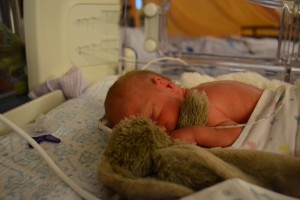Bij Rico van Dongen, honorary member of the Bioelectronics Group

An Electronic Fetal Monitor, also known as cardiotocograph (CTG), to record the fetal heartbeat and the uterine contractions during pregnancy
On December first of last year I became the proud father of a baby boy, Wouter. Unfortunately, the pregnancy and birth did not go according to plan and my wife and I were exposed to a long period of hospitalization and a lot of medical devices.
It all started October last year when my wife was hospitalized with pre-eclampsia, a form of pregnancy related high blood pressure. The fact is there is no cure or proper treatment for this besides inducing labor and abort the pregnancy. Being only 25 weeks pregnant at the time the survival changes of the baby are already quite good thanks to modern neonatology, but certainly not without complications.
Obviously the best path for our unborn child was to extend the pregnancy for as long as possible and try to control the high blood pressure with medication. Two months of intensive hospital care and almost weekly increasing dose of medication followed.
The heartbeat of our baby was monitored daily by means of cardiotocography, CTG, to check if he could still handle the high dose of medication. The resulting graphs were, according to the doctors, sub-optimal. This resulted in the fact that my wife was connected to this CTG machine for up to 4 hours a day before the doctors were confident again that our baby was stable.
As a father confident in the strength of our child I soon blamed the machine for this sub-optimal picture. It was not long before we realized that almost all drops in heartbeat correlated with movement of the baby. As an engineer, my hands were itching with the urge to re-write the software of this machine and add an additional graph with signal quality to the output.
Weeks of endless CTG and blood pressure medication passed. By the time of the 30st week of pregnancy oral medication was nog longer sufficient and the real heavy stuff was administered through IV drip. Two weeks passed until there was no other option than to abort the pregnancy.
Although usually inducing labor is not successful at this early terms my wife managed to pull it off and finally our son was born. Although weighing only 1417g it was a strong guy that could already breath on his own. He spent only one night at the intensive care for observation before we could move him to the high-care section.
The good news only lasted half a day. After a routine ultrasound of the brains the doctors discovered a massive hemorrhage. His right ventricle was half filled with blood and the left completely filled. At the left side there was already sign of damage to brain tissue. The damage concentrated to the connections from the motor cortex to the central nerve system. The neonatologist explained to us that bleedings at premature born babies are not that uncommon, the strange thing about our case was that the bleeding already occurred before birth. Luckily the human brain, and especially the undeveloped brain of babies, is capable of finding new connections and avoid damaged regions.
There is a chance that we won’t be able to notice anything abnormal in the way our baby moves but it was clear that our days of worrying and hospital visits were long from over. But first things first, being only 1417g our boy needed to gain strength in an incubator.
The incubator is, again, a collection of medical electronics where the engineer in me would love to make some improvements. Take for example the electrodes used for monitoring the heartbeat and the sensor for measuring blood oxygen saturation. I’m not sure if it was the way of handling our baby but somehow the leads always seemed to be tangled. Small wireless sensors would be very helpful in this situation. Perhaps this is a good use for low power ultra-wide-band technology. On the other hand, it is nice to see the designers already took some effort making the electrodes fit in to the cuddly baby environment by printing cute teddy bear pictures on them.
Another one and a half month passed before out baby boy was strong enough to leave the hospital. As a final check an MRI was made. It clearly showed the damaged regions but also that the brains developed normal and that the remaining blood was gradually cleared away. At this point he is just like any other baby. There is nothing wrong with his ability to cry us awake during the night or to kick off his socks. Nevertheless, his development will be closely monitored with perhaps even more electronics.
I guess my messages to other biomedical engineers is first of all, keep up the good work. Until you need the electronics we design you don’t really realize how valuable our work is. Secondly, I think it would be helpful to try to evaluate the design from the viewpoint of the patients and medical personnel that are using your products.
Rico van Dongen, Febr. 6, 2016

Baby Wouter van Dongen
